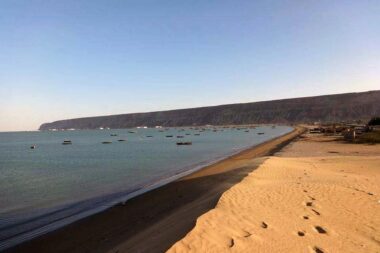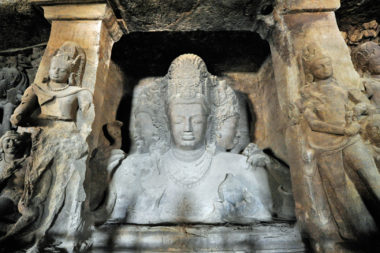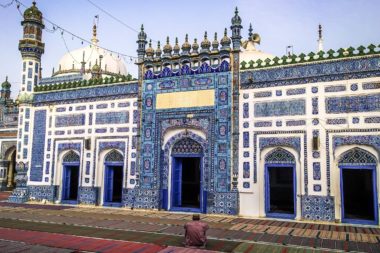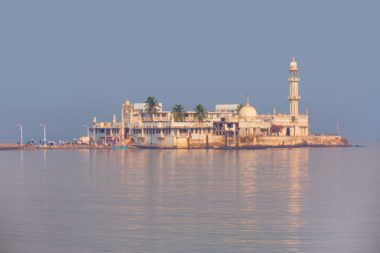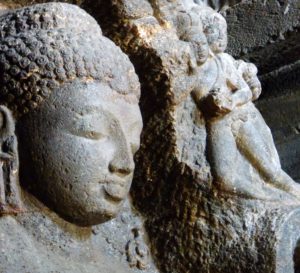 Ancient Indian History primarily begins from the Indus Valley Civilization. After the desolation of Indus Valley Civilization, many civilizations were established in India due to the presence of rich natural resources in this land. India has witnessed the rise and fall of many powerful kingdoms. Being the birthplace of so many kingdoms and civilizations, the country has always been culturally diverse. We see versatility in every corner of India, be it art, people, language, or lifestyle. Various religions, kingdoms, and people have extensively contributed to the cultural heritage of India including the monuments, different forms of architecture, forts, and caves.
Ancient Indian History primarily begins from the Indus Valley Civilization. After the desolation of Indus Valley Civilization, many civilizations were established in India due to the presence of rich natural resources in this land. India has witnessed the rise and fall of many powerful kingdoms. Being the birthplace of so many kingdoms and civilizations, the country has always been culturally diverse. We see versatility in every corner of India, be it art, people, language, or lifestyle. Various religions, kingdoms, and people have extensively contributed to the cultural heritage of India including the monuments, different forms of architecture, forts, and caves.
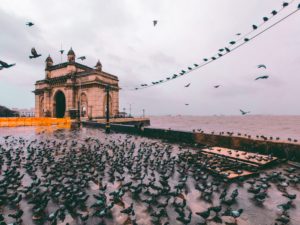 Located in a remote area in the Indian state of Maharashtra, the Ajanta and Ellora Caves are the two precious gems of Indian history. Though we find the mention of these caves in the writings of Chinese Buddhist travelers coming to India in the medieval era, the historic Ajanta caves remained hidden from people’s eyes until they were accidentally discovered by colonial British officer Captain John Smith in 1819. The group of caves in Ajanta and Ellora were bestowed with the prestigious status of UNESCO World Heritage Site in 1983.
Located in a remote area in the Indian state of Maharashtra, the Ajanta and Ellora Caves are the two precious gems of Indian history. Though we find the mention of these caves in the writings of Chinese Buddhist travelers coming to India in the medieval era, the historic Ajanta caves remained hidden from people’s eyes until they were accidentally discovered by colonial British officer Captain John Smith in 1819. The group of caves in Ajanta and Ellora were bestowed with the prestigious status of UNESCO World Heritage Site in 1983.
But do you know why these centuries-old caves bear so much significance in the chapter of ancient Indian history?
So, let us unfold together the enthralling history hidden behind the existence of these primeval caves that have always intrigued our curious souls.
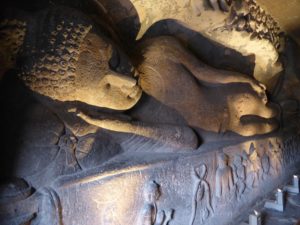 Ajanta Caves – These caves are located in a distant river valley, 105 km away from Aurangabad city in Maharashtra. The oldest cave temples and monasteries in Ajanta date back to the 2nd Century BC. Presently, the 30 existing caves in Ajanta are divided into two parts. The earlier caves were established in the Satavahana period whereas the later caves came up during the Vakataka period. The Chaityas or a Buddhist prayer hall with a stupa at the end are made up of 5 caves and the rest of the caves are Viharas or Buddhist monasteries. Now, the Archeological Survey of India (ASI) looks after the entire site. The paintings on the cave walls of Ajanta are regarded as exceptional examples of ancient Indian art. Among them, the murals of Cave 1, 2, 16, and 17 are the finest ones.
Ajanta Caves – These caves are located in a distant river valley, 105 km away from Aurangabad city in Maharashtra. The oldest cave temples and monasteries in Ajanta date back to the 2nd Century BC. Presently, the 30 existing caves in Ajanta are divided into two parts. The earlier caves were established in the Satavahana period whereas the later caves came up during the Vakataka period. The Chaityas or a Buddhist prayer hall with a stupa at the end are made up of 5 caves and the rest of the caves are Viharas or Buddhist monasteries. Now, the Archeological Survey of India (ASI) looks after the entire site. The paintings on the cave walls of Ajanta are regarded as exceptional examples of ancient Indian art. Among them, the murals of Cave 1, 2, 16, and 17 are the finest ones.
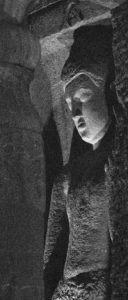
Cave 1 – According to historians, the paintings in this cave were made under the authorization of Vakataka king Harishena as a mark of royalty. The murals in Cave 1 depict the stories of Jataka tales where Buddha belonged to royal lineage in his previous births. The facade of the cave is adorned with spectacular sculptures. Also, the architecture is intricate and amazes visitors from all around the world.
Cave 2 – The walls and pillars of cave 2 are ornamented with thick paintings and beautiful motifs. Through these paintings, the Indian society of the 5th century BC has been portrayed. Apart from society, artworks and rock carvings also show the importance of women in contemporary society. A lot of carvings in this cave are devoted to Hariti, the Buddhist goddess of fertility.
Cave 16 – Vatakata emperor Harishena’s minister, Varahadeva commissioned the building of this cave which was dedicated to the community of Buddhist monks. Scholars opine that Cave 16 plays a pivotal part in defining the architecture of the group of caves in Ajanta. The cave is a Vihara with an established entrance. The cave paintings explicitly narrate the stories from Jataka tales, mythological incidents, and scenes from Buddha’s life.
 Cave 17 – This cave of Ajanta is the abode of the most well-conserved set of paintings that have given this cave a significant place in Indian art history. The pillars of this cave are carved with unconventional motifs. It has wide windows for the proper passing of sunlight and the paintings showcase interesting stories from Indian mythology. The various portrayals of Buddha in the walls of this cave will surely offer an enthralling experience to the visitors.
Cave 17 – This cave of Ajanta is the abode of the most well-conserved set of paintings that have given this cave a significant place in Indian art history. The pillars of this cave are carved with unconventional motifs. It has wide windows for the proper passing of sunlight and the paintings showcase interesting stories from Indian mythology. The various portrayals of Buddha in the walls of this cave will surely offer an enthralling experience to the visitors.
After the fall of the Vakataka dynasty, the Ajanta caves were deserted.
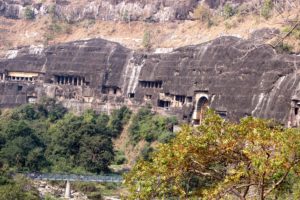 Ellora Caves – Placed in the lap of Sahyadri hills in Maharashtra’s Aurangabad district, Ellora Caves, a UNESCO World Heritage Site is a two-hour drive from Ajanta Caves. There are 34 caves in the cave complex of which 17 are Hindu, 12 are Buddhist and 5 are Jain Caves. Some parts of the Hindu and Buddhist caves were established during the reign of the Rashtrakuta dynasty and the Yadava kings made the Jain caves. Constructed between 600 to 1000 CE, the Ellora caves used to be the rest houses of Buddhist and Jain monks visiting India.
Ellora Caves – Placed in the lap of Sahyadri hills in Maharashtra’s Aurangabad district, Ellora Caves, a UNESCO World Heritage Site is a two-hour drive from Ajanta Caves. There are 34 caves in the cave complex of which 17 are Hindu, 12 are Buddhist and 5 are Jain Caves. Some parts of the Hindu and Buddhist caves were established during the reign of the Rashtrakuta dynasty and the Yadava kings made the Jain caves. Constructed between 600 to 1000 CE, the Ellora caves used to be the rest houses of Buddhist and Jain monks visiting India.
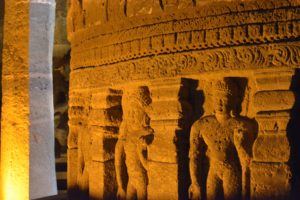 Hindu Caves – These caves were made in two phases. A part of the Hindu caves was made during the Kalachuris period from the 6th to 8th century whereas the building of cave 14, 15, 16 was commissioned by the Rashtrakuta kings. The 17 Hindu caves are decorated with sculptures and murals from Hindu mythology. These archaic Hindu Caves are primarily dedicated to Lord Shiva and in each of the cave, the Shiva Linga is placed at the center.
Hindu Caves – These caves were made in two phases. A part of the Hindu caves was made during the Kalachuris period from the 6th to 8th century whereas the building of cave 14, 15, 16 was commissioned by the Rashtrakuta kings. The 17 Hindu caves are decorated with sculptures and murals from Hindu mythology. These archaic Hindu Caves are primarily dedicated to Lord Shiva and in each of the cave, the Shiva Linga is placed at the center.
Kailasha temple or cave 16 has received fame from all over the world for its unique architectural style and intricate artwork. Built during the 8th century by Rashtrakuta King Krishna I, it is the largest single monolithic rock-cut temple in this world.
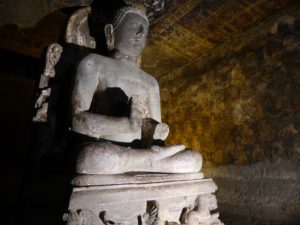 Buddhist Caves – These caves are located in the southern part of the Ellora caves and they consist of shrines, monasteries, Bodhisattvas, and paintings related to Buddha’s life. It is believed by historians that the Hindu caves were built earlier than the Buddhist caves. Cave 6 was the first Buddhist cave to be built and cave 12 was the last one. Vishwakarma Cave or Cave 10, also called the Carpenter’s Cave is exceptional in its style as the finishing rock appears to be a wooden beam, and a 15 ft statue of preaching Buddha is placed inside the stupa hall.
Buddhist Caves – These caves are located in the southern part of the Ellora caves and they consist of shrines, monasteries, Bodhisattvas, and paintings related to Buddha’s life. It is believed by historians that the Hindu caves were built earlier than the Buddhist caves. Cave 6 was the first Buddhist cave to be built and cave 12 was the last one. Vishwakarma Cave or Cave 10, also called the Carpenter’s Cave is exceptional in its style as the finishing rock appears to be a wooden beam, and a 15 ft statue of preaching Buddha is placed inside the stupa hall.
 Jain Caves – The five Jain caves which are smaller in size than the Hindu and Buddhist caves are located on the northern side of the Ellora caves. The caves feature pillared verandah and mandapa. The paintings portray Yaksa, Yaksi, Gods, Goddesses, Jain mythological figures and worshipers of the contemporary time. These caves belong to the Digambara sect of the Jains.
Jain Caves – The five Jain caves which are smaller in size than the Hindu and Buddhist caves are located on the northern side of the Ellora caves. The caves feature pillared verandah and mandapa. The paintings portray Yaksa, Yaksi, Gods, Goddesses, Jain mythological figures and worshipers of the contemporary time. These caves belong to the Digambara sect of the Jains.
Chota Kialasha or Cave no. 30 was built in a similar style as the actual Kailasha Temple along with the Indra Sabha, Cave 32, the most beautiful one among the five Jain caves. Inside the Indra Sabha, there are two notable statues of Indra as well as the statues of other dancers and deities.
The fine artworks of Ajanta and Ellora caves are irreplaceable as they are the finest surviving specimens of ancient Indian art and carries the cultural heritage of India. The confluence of Hindu, Buddhist, and Jain sculptures adds a different dimension to the architectural style of the caves and makes it exceptionally valuable. Besides being amazed by its enchanting history, let us also be responsible and respectful towards these archaic artworks while visiting the place and contribute to its proper preservation.



